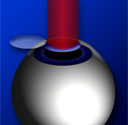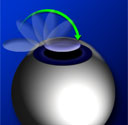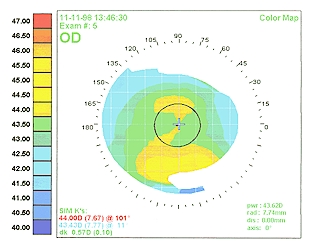|














- Palisades Office:
- 970 Monument St. #204
- Pacific Palisades, CA
- (310) 454-5521
- Studio City Office:
- 12229 Ventura Blvd.
- Studio City, CA
- (818) 623-8900
-
-
| |
How LASIK works | Am I a candidate for
LASIK? | Who can have LASIK?
LASIK results | Your
LASIK consultation
Your LASIK surgery | Possible side
effects and complications
LASIK (Laser In Situ Keratomileusis) is the most popular and versatile of
vision correction procedures known as refractive surgery. LASIK uses the excimer
laser to reduce or eliminate nearsightedness, farsightedness, and astigmatism by modifying the eye
to improve your vision.
eliminate nearsightedness, farsightedness, and astigmatism by modifying the eye
to improve your vision.
How LASIK works
LASIK uses the excimer laser to reshape the clear dome-shaped cornea on the front of the
eye so that light will be properly focused
to achieve a sharp image on the retina:
| STEP 1. After a drop of
anesthetic is applied to the eye, an instrument known as a
microkeratome is used to create a thin flap of corneal tissue,
which is folded back. |
 |
| STEP 2.
While the patient looks at a blinking red light, the
excimer laser
removes a predetermined amount of tissue from
the inner cornea to correct their refractive error. The
cornea is made flatter to treat nearsightedness, steeper to treat
farsightedness and/or more spherical to correct astigmatism. |

|
| STEP 3. The
corneal flap is placed back in its original position where it
bonds without the need of stitches. LASIK can treat low to very
severe refractive errors.
The procedure results in a rapid recovery, allowing most
patients to resume to normal activity within one to two days. Results are
overwhelmingly successful.
|

|
|
You are probably a good candidate for LASIK if the answer to the following
questions is "Yes:"
1. Is your eye prescription
stable? Has it been about the same for at least one year?
2. Are you 21 years of age or
older?
3. Would you like to have the
freedom from dependency on your glasses or contact lenses?
4. Do you have less than 12 diopters of myopia (nearsightedness), 5 diopters
astigmatism, or 4 diopters hyperopia (farsightedness)?
AND the answer to the following questions is "No:"
Do you have any corneal
diseases such as keratoconus or herpes infection of the eye?
Do you have an autoimmune
disease?
Are you currently pregnant or
planning to become pregnant in the near future?
Do you have any retinal disease?
The LASIK procedure is characterized by rapid visual recovery and little to
no pain, and has fast become the refractive procedure of choice by both
ophthalmologists and patients worldwide.
Most LASIK patients achieve unaided vision between 20/20 and 20/40. This is
functional vision for most people, permitting many ordinary activities such as
sports, watching television and driving. Vision improvement is rapid with much
of the improvement already apparent on the first day after the procedure. While
slight fluctuations in vision can occur in the first week, most patients return
to regular activities the next day.
Your LASIK consultation
Preparing for your consultation
- Please bring your current glasses, previous glasses or your contact lenses
to the examination.
- Please do not wear soft contact lenses three days before the consultation
or hard contact lenses for two weeks before your consultation. This will
allow the surface of your cornea to resume its normal shape.
- Your eyes will be dilated during the examination; therefore you should
bring sunglasses to assist you in driving home after the examination.
Your consultation
Your LASIK consultation will include a comprehensive eye examination and special
testing to design a treatment plan for your individual needs. The testing will
include:
- A refraction (a measurement of the optics of your eye)
- Certain patients will also require a topographic examination of the
surface of your eye.
 This computerized image maps the curvature of the cornea, similar to a geological relief map (see example
at right). Each color represents a different steepness of curvature. The exam mapping shown at the right, from an actual LASIK candidate,
indicates a good profile for laser correction of nearsightedness combined
with astigmatism.
This computerized image maps the curvature of the cornea, similar to a geological relief map (see example
at right). Each color represents a different steepness of curvature. The exam mapping shown at the right, from an actual LASIK candidate,
indicates a good profile for laser correction of nearsightedness combined
with astigmatism.
- A dilated refraction to verify your prescription
- A comprehensive discussion of your individual eye health and recom-
endations for your refractive laser surgery.
Your LASIK surgery
Preparing for your laser surgery
- Please do not wear soft contact lenses three full days before the laser
surgery or hard contact lenses for two weeks before your surgery. This will
allow the surface of your cornea to resume its normal shape.
- If you have any questions regarding your surgery please call us at
310-454-5521 and we will be happy to help.
- After your surgery you should expect to go home and rest quietly for the
remainder of the day.
Your laser surgery
- You will check in one-half hour prior to your scheduled surgery time. Upon
arrival your consent forms will be signed and collected. You will receive
your post-operative instructions for review.
- You will be called into a preop room and given a mild sedative to help you relax.
- When ready for surgery our nurse will bring you to the laser surgery
suite.
- You will remain awake and comfortable during the laser procedure. A
numbing topical anesthetic drop will be put into your eye and you will be
prepared for the laser treatment.
- Dr. Sawusch will then begin the LASIK procedure. This procedure will take
approximately 8-10 minutes per eye, and you will remain lying comfortably
on a reclining chair throughout the laser procedure.
- When the surgery is complete, a nurse will escort you to the waiting room
where you will rest for about 10 minutes.
- Dr. Sawusch will then examine your eyes and then you will be ready to go
home.
- Please remember all patients need to be escorted home from the surgery. You should plan to be at the
Laser Center for approximately 1 hour.
After your laser surgery
- For the first day and night your eye will be protected with a clear
plastic shield. The shield will stay on until your post-operative
appointment the next day.
- Upon arriving home, sleep and relaxation for the eye are best for
recovery.
- You will need to follow post-operative instructions for the eye drop
medications beginning the day after your laser procedure.
- While most patients experience little or no discomfort after LASIK
surgery, some do experience low to moderate pain.
- You will return to Dr. Sawusch's office the next day for your one-day
post-operative exam. At this exam your shield will be removed and your
vision measured. The vision will be improved but may remain partially
blurry. You will begin to see noticeable results right after surgery. At
your one-day exam you should have 70%-90% of the achievable vision.
- A schedule of post-operative and follow up appointments will be made for
you. It is very important to carefully follow all medication and
post-operative instructions and to attend all scheduled appointments.
- Please remember to be particularly careful to avoid having any foreign
matter in the eye for at least two weeks. This includes avoiding soap and
water in the eye, do not wear
eye makeup or other cosmetics around the eye, and do not swim or get water
in the eye for at least two weeks.
- You will then be able to begin a lifestyle with the freedom of new vision.
For more information, see our frequently
asked questions (FAQ).
Possible side effects and complications
As with any type of surgery, complications are possible. Every effort is
made to minimize risks, but serious or long-term complications can never be
fully eliminated. Common side effects after refractive surgery include:
- Light sensitivity may rapidly improve over days to weeks; however,
a few individuals have ongoing light sensitivity for six months or longer.
- Glare from bright light sources, such as oncoming headlights while
driving at night may occur but generally improves and often resolves over
the first six months after the procedure. In a few cases, patients use eye
drops to keep the pupil small, thereby reducing glare.
- Shadowing, doubling of vision, or "ghost images" usually
resolves on its own, but sometimes needs 2 or more further treatments.
- Variable vision may occur depending upon the procedure for weeks to
months after the procedure. Some individuals experience a small fluctuation
in the precise focus over the course of the day. This daily fluctuation
generally subsides during the month after the surgery.
- Overcorrection and undercorrection occurs in some patients who feel
that the uncorrected vision is not as good as desired. This may require the
use of glasses, contact lenses, or further laser procedures.
- No list of complications can be complete. Any medical or surgical
procedure has innumerable potential risks, both foreseen and unforeseen.
|